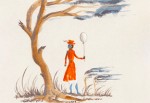Here's a great article on intuition, one that helps explain some anomalies that occur in my work with apprentices. One in particular relates to something I've observed when I conduct remote viewing exercises over the phone and computer.
I find that when I "send" (transmit) a specific image to the apprentice, one that I'm intentionally focused on, the scope of the information that the he/she receives extends way beyond any visual impressions that they might have intuited from the picture. They pick up on the smallest details that they couldn't possibly have known.
One apprentice unknowingly intuited from a picture I was transmitting, that it was the first in the series I'd actually photographed myself. In the feedback phase, she reported — "The moment you sent that image, I said to myself, 'I want to see this one through Louise's eyes!'" — and that's exactly what she'd done! Not only had she received visual impressions from the picture, but additional details that involved my emotions and circumstances at the time I'd taken the photo! Fascinating stuff...
Here's more about this from the article, "The Science of Intuition: An Eye-Opening Guide to Your Sixth Sense"
By Annie Murphy Paul
O, The Oprah Magazine | July 14, 2011
Double Vision
Human eyesight might seem straightforward: The eye receives images, the brain processes them. But we actually have two vision tracks—one conscious, the other intuitive—and as a result, the eye sees far more than we generally realize. For instance, in a phenomenon known as blindsight, people who have gone blind because of brain damage can still navigate an obstacle course or identify emotion on a person's face, even though they can't consciously see it. Their intuitive vision track is receiving visual stimuli, even though their conscious vision track isn't; they know what's around them—they just don't know how they know.
Blindsight patients are an extreme example, but they illustrate a phenomenon everyone experiences: We absorb and retain visual information that doesn't penetrate our conscious mind. Joy Hirsch, PhD, director of the fMRI Research Center at Columbia University Medical Center, has shown that our brains react with anxiety to images of faces expressing fear—even when such images are flashed so quickly we have no idea we've seen them. "The amygdala, which plays an important role in emotional processing, activates in response to these pictures even when they're displayed for only 33 milliseconds—too fast to register in our conscious awareness," says Hirsch. This reaction stems from our earliest origins: When our ancestors confronted strangers, those who quickly discerned the newcomers' feelings and motives were more likely to survive.
Tune In: "We all process things that we're not consciously aware of—it's a feeling of knowing that uses an older brain structure," says neuroscientist Beatrice de Gelder, PhD, who researches blindsight. But because we're so dependent on our sense of sight, she says, we're not used to trusting our intuitive vision track. "If you find yourself in a situation that's making you feel nervous, you may have spotted a reason for concern without even knowing it," says Hirsch. "Pay attention to the sensation."
Read more: http://www.oprah.com/spirit/Scientific-Facts-About-Intuition-Developing-Intuition#ixzz1SqMN4Ua3

